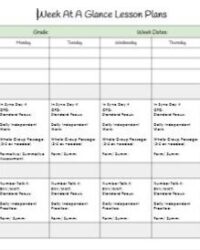In the world of education, few names resonate with as much authority and practical wisdom as Dr. Anita Archer. Her work on explicit instruction has transformed classrooms, empowering educators to deliver clear, concise, and highly effective lessons that ensure student understanding and success. It’s not just about what you teach, but how you teach it, and explicit instruction provides a powerful framework for achieving remarkable learning outcomes consistently.
For many teachers, the challenge lies in translating these robust principles into daily practice. That’s where a structured approach, often facilitated by a well-designed lesson plan template, becomes invaluable. Imagine having a roadmap that guides you through each crucial step, ensuring you cover all bases from concept introduction to independent mastery. This systematic approach simplifies preparation, enhances delivery, and ultimately leads to more confident and capable students.
Understanding the Core Principles of Explicit Instruction
Explicit instruction is much more than just direct teaching; it is a systematic, rigorous, and highly effective instructional approach that is particularly beneficial for teaching new skills, concepts, or strategies. It’s built on the premise that clarity is king, and students learn best when information is presented directly, concisely, and with abundant opportunities for practice and feedback. It reduces ambiguity and ensures all students, regardless of their prior knowledge or learning style, have a clear path to understanding.
At its heart, explicit instruction is about breaking down complex tasks into smaller, manageable steps. It’s about showing students exactly what to do, guiding them as they try, and then allowing them to practice independently until mastery is achieved. This predictable structure builds confidence and reduces cognitive overload, allowing students to focus on the content rather than trying to decipher the teaching method.
The “I Do, We Do, You Do” Framework
Perhaps the most recognizable hallmark of explicit instruction is the “I Do, We Do, You Do” model. This progressive release of responsibility is crucial for effective learning. It begins with the teacher taking full responsibility (“I Do”), then sharing that responsibility with students (“We Do”), and finally transferring responsibility to the students (“You Do”).
During the “I Do” phase, the teacher models the skill or concept explicitly, thinking aloud and demonstrating exactly what they want students to learn. There’s no guessing involved; the teacher shows, tells, and explains. Following this, the “We Do” phase involves guided practice, where students practice the new skill with the teacher’s support and immediate corrective feedback. This is a critical bridge where misconceptions can be addressed before they become ingrained. Finally, in the “You Do” phase, students work independently, applying the skill on their own, allowing the teacher to assess individual mastery and identify any remaining learning gaps.
Key Elements for Effective Delivery
Beyond the “I Do, We Do, You Do” structure, explicit instruction emphasizes several other critical components. Checking for understanding is woven throughout the lesson, not just at the end. Teachers consistently ask questions, observe student responses, and provide immediate, specific feedback. This ongoing assessment ensures that students are grasping the material before moving on. Additionally, opportunities for review and cumulative practice are built into the teaching sequence, ensuring that new knowledge is reinforced and retained over time, preventing information from fading away.
Think of it as building a sturdy house: you wouldn’t just throw up the walls without a solid foundation or check the plumbing after it’s all enclosed. Each step is carefully laid, inspected, and reinforced, ensuring the final structure is robust and reliable. Explicit instruction applies this same meticulous approach to learning, guaranteeing that students develop a deep and lasting understanding.
Building Your Effective Lesson Plan with a Dedicated Template
While the principles of explicit instruction are powerful, implementing them consistently across every lesson can feel daunting without a clear framework. This is where an anita archer explicit instruction lesson plan template becomes an indispensable tool for any educator. It’s not about stifling creativity, but rather about providing a structured canvas upon which you can paint your dynamic lessons, ensuring all the vital elements for student success are present and accounted for.
A well-designed template serves as a checklist and a guide, prompting you to consider each phase of instruction: from clearly defining learning objectives to planning for guided practice, independent work, and effective assessment. It helps prevent overlooking crucial steps, ensures a logical flow to your lesson, and fosters consistency in your teaching approach. Instead of reinventing the wheel for every new topic, you can focus your energy on tailoring the content and activities to your students’ specific needs, knowing the instructional framework is solid.
The beauty of using such a template is in its ability to streamline your planning process, saving valuable time while simultaneously elevating the quality of your instruction. It helps translate abstract teaching principles into concrete, actionable steps, making the complex art of effective teaching more accessible and manageable. By following a consistent structure, both teachers and students benefit from the predictability and clarity, leading to a more productive and engaging learning environment.
- Clearly Stated Learning Objectives
- Anticipatory Set or Lesson Introduction
- Teacher Modeling (I Do)
- Guided Practice (We Do)
- Independent Practice (You Do)
- Checks for Understanding and Formative Assessment
- Lesson Closure and Review
- Differentiation Strategies for Varied Learners
- Materials and Resources Needed
Embracing the structure of explicit instruction, particularly with the aid of a detailed lesson plan template, truly empowers educators to teach with precision and impact. It moves beyond simply covering content to ensuring deep and lasting student comprehension. This systematic approach builds a strong foundation for learning, giving every student the best possible chance to succeed.
Ultimately, by consistently applying these proven strategies, teachers can cultivate classrooms where students are not just passively receiving information, but actively engaging with it, understanding it, and internalizing it. The result is a more confident, capable, and successful student body, ready to tackle new challenges and thrive academically.


